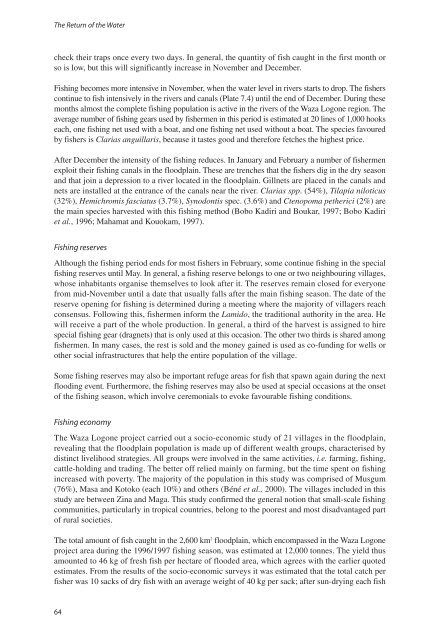The return of the water - IUCN
The return of the water - IUCN
The return of the water - IUCN
Create successful ePaper yourself
Turn your PDF publications into a flip-book with our unique Google optimized e-Paper software.
<strong>The</strong> Return <strong>of</strong> <strong>the</strong> Water<br />
check <strong>the</strong>ir traps once every two days. In general, <strong>the</strong> quantity <strong>of</strong> fish caught in <strong>the</strong> first month or<br />
so is low, but this will significantly increase in November and December.<br />
Fishing becomes more intensive in November, when <strong>the</strong> <strong>water</strong> level in rivers starts to drop. <strong>The</strong> fishers<br />
continue to fish intensively in <strong>the</strong> rivers and canals (Plate 7.4) until <strong>the</strong> end <strong>of</strong> December. During <strong>the</strong>se<br />
months almost <strong>the</strong> complete fishing population is active in <strong>the</strong> rivers <strong>of</strong> <strong>the</strong> Waza Logone region. <strong>The</strong><br />
average number <strong>of</strong> fishing gears used by fishermen in this period is estimated at 20 lines <strong>of</strong> 1,000 hooks<br />
each, one fishing net used with a boat, and one fishing net used without a boat. <strong>The</strong> species favoured<br />
by fishers is Clarias anguillaris, because it tastes good and <strong>the</strong>refore fetches <strong>the</strong> highest price.<br />
After December <strong>the</strong> intensity <strong>of</strong> <strong>the</strong> fishing reduces. In January and February a number <strong>of</strong> fishermen<br />
exploit <strong>the</strong>ir fishing canals in <strong>the</strong> floodplain. <strong>The</strong>se are trenches that <strong>the</strong> fishers dig in <strong>the</strong> dry season<br />
and that join a depression to a river located in <strong>the</strong> floodplain. Gillnets are placed in <strong>the</strong> canals and<br />
nets are installed at <strong>the</strong> entrance <strong>of</strong> <strong>the</strong> canals near <strong>the</strong> river. Clarias spp. (54%), Tilapia niloticus<br />
(32%), Hemichromis fasciatus (3.7%), Synodontis spec. (3.6%) and Ctenopoma pe<strong>the</strong>rici (2%) are<br />
<strong>the</strong> main species harvested with this fishing method (Bobo Kadiri and Boukar, 1997; Bobo Kadiri<br />
et al., 1996; Mahamat and Kouokam, 1997).<br />
Fishing reserves<br />
Although <strong>the</strong> fishing period ends for most fishers in February, some continue fishing in <strong>the</strong> special<br />
fishing reserves until May. In general, a fishing reserve belongs to one or two neighbouring villages,<br />
whose inhabitants organise <strong>the</strong>mselves to look after it. <strong>The</strong> reserves remain closed for everyone<br />
from mid-November until a date that usually falls after <strong>the</strong> main fishing season. <strong>The</strong> date <strong>of</strong> <strong>the</strong><br />
reserve opening for fishing is determined during a meeting where <strong>the</strong> majority <strong>of</strong> villagers reach<br />
consensus. Following this, fishermen inform <strong>the</strong> Lamido, <strong>the</strong> traditional authority in <strong>the</strong> area. He<br />
will receive a part <strong>of</strong> <strong>the</strong> whole production. In general, a third <strong>of</strong> <strong>the</strong> harvest is assigned to hire<br />
special fishing gear (dragnets) that is only used at this occasion. <strong>The</strong> o<strong>the</strong>r two thirds is shared among<br />
fishermen. In many cases, <strong>the</strong> rest is sold and <strong>the</strong> money gained is used as co-funding for wells or<br />
o<strong>the</strong>r social infrastructures that help <strong>the</strong> entire population <strong>of</strong> <strong>the</strong> village.<br />
Some fishing reserves may also be important refuge areas for fish that spawn again during <strong>the</strong> next<br />
flooding event. Fur<strong>the</strong>rmore, <strong>the</strong> fishing reserves may also be used at special occasions at <strong>the</strong> onset<br />
<strong>of</strong> <strong>the</strong> fishing season, which involve ceremonials to evoke favourable fishing conditions.<br />
Fishing economy<br />
<strong>The</strong> Waza Logone project carried out a socio-economic study <strong>of</strong> 21 villages in <strong>the</strong> floodplain,<br />
revealing that <strong>the</strong> floodplain population is made up <strong>of</strong> different wealth groups, characterised by<br />
distinct livelihood strategies. All groups were involved in <strong>the</strong> same activities, i.e. farming, fishing,<br />
cattle-holding and trading. <strong>The</strong> better <strong>of</strong>f relied mainly on farming, but <strong>the</strong> time spent on fishing<br />
increased with poverty. <strong>The</strong> majority <strong>of</strong> <strong>the</strong> population in this study was comprised <strong>of</strong> Musgum<br />
(76%), Masa and Kotoko (each 10%) and o<strong>the</strong>rs (Béné et al., 2000). <strong>The</strong> villages included in this<br />
study are between Zina and Maga. This study confirmed <strong>the</strong> general notion that small-scale fishing<br />
communities, particularly in tropical countries, belong to <strong>the</strong> poorest and most disadvantaged part<br />
<strong>of</strong> rural societies.<br />
<strong>The</strong> total amount <strong>of</strong> fish caught in <strong>the</strong> 2,600 km 2 floodplain, which encompassed in <strong>the</strong> Waza Logone<br />
project area during <strong>the</strong> 1996/1997 fishing season, was estimated at 12,000 tonnes. <strong>The</strong> yield thus<br />
amounted to 46 kg <strong>of</strong> fresh fish per hectare <strong>of</strong> flooded area, which agrees with <strong>the</strong> earlier quoted<br />
estimates. From <strong>the</strong> results <strong>of</strong> <strong>the</strong> socio-economic surveys it was estimated that <strong>the</strong> total catch per<br />
fisher was 10 sacks <strong>of</strong> dry fish with an average weight <strong>of</strong> 40 kg per sack; after sun-drying each fish<br />
64












